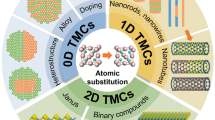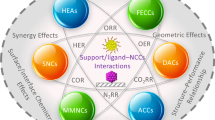Abstract
Two-dimensional (2D) cuprous oxide (Cu2O) nanostructures (NSs) of monolayer thickness were synthesized on Au(111) and characterized using atomic-resolution scanning tunneling microscopy, X-ray photoelectron spectroscopy, and density functional theory (DFT) calculations. The surface and edge structures of 2D Cu2O were resolved at the atomic level and found to exhibit a graphene-like lattice structure. Cu2O NSs grew preferentially at the face centered cubic (fcc) domains of Au(111). Depending on the annealing temperature, the shapes and structures of Cu2O NSs were found to vary from elongated islands with a defective hexagonal lattice (mostly topological 5–7 defects) to triangular NSs with an almost-perfect hexagonal lattice. The edge structures of Cu2O NSs also varied with the annealing temperature, from predominantly the arm-chair 56 structure at 400 K to almost exclusively the zig-zag structure at 600 K. DFT calculations suggested that the herringbone ridges of Au(111) confined the growth and structure of Cu2O NSs on Au(111). As such, the arm-chair edges of Cu2O NSs, which are less stable than the zig-zag edges, could be exposed preferentially at 400 K. Cu2O NSs developed into the thermodynamically-favored triangular form and exposed zig-zag edges at 600 K, when the Au(111) substrate became mobile. The confined growth of 2D cuprous oxide on Au(111) demonstrated the importance of metal-oxide interactions in tuning the structures of supported 2D oxide NSs.

Similar content being viewed by others
References
Ruiz Puigdollers, A.; Schlexer, P.; Tosoni, S.; Pacchioni, G. Increasing oxide reducibility: The role of metal/oxide interfaces in the formation of oxygen vacancies. ACS Catal. 2017, 7, 6493–6513.
Freund, H. J. The surface science of catalysis and more, using ultrathin oxide films as templates: A perspective. J. Am. Chem. Soc. 2016, 138, 8985–8996.
Bersuker, G.; McKenna, K.; Shluger, A. Silica and high-k dielectric thin films in microelectronics. In Oxide Ultrathin Films.Wiley-VCH Verlag GmbH & Co. KGaA: Weinheim, Germany, 2011; pp 101–118.
Lusk, M. T.; Carr, L. D. Nanoengineering defect structures on graphene. Phys. Rev. Lett. 2008, 100, 175503.
Carr, L. D.; Lusk, M. T. Defect engineering: Graphene gets designer defects. Nat. Nanotechnol. 2010, 5, 316–317.
Lahiri, J.; Lin, Y.; Bozkurt, P.; Oleynik, I. I.; Batzill, M. An extended defect in graphene as a metallic wire. Nat. Nanotechnol. 2010, 5, 326–329.
Kotakoski, J.; Krasheninnikov, A. V.; Kaiser, U.; Meyer, J. C. From point defects in graphene to two-dimensional amorphous carbon. Phys. Rev. Lett. 2011, 106, 105505.
Björkman, T.; Kurasch, S.; Lehtinen, O.; Kotakoski, J.; Yazyev, O. V.; Srivastava, A.; Skakalova, V.; Smet, J. H.; Kaiser, U.; Krasheninnikov, A. V. Defects in bilayer silica and graphene: Common trends in diverse hexagonal twodimensional systems. Sci. Rep. 2013, 3, 3482.
Yang, B.; Boscoboinik, J. A.; Yu, X.; Shaikhutdinov, S.; Freund, H. J. Patterned defect structures predicted for graphene are observed on single-layer silica films. Nano Lett. 2013, 13, 4422–4427.
Surnev, S.; Fortunelli, A.; Netzer, F. P. Structure–property relationship and chemical aspects of oxide–metal hybrid nanostructures. Chem. Rev. 2013, 113, 4314–4372.
Cabrera, N.; Mott, N. F. Theory of the oxidation of metals. Rep. Prog. Phys. 1949, 12, 163–184.
Zavabeti, A.; Ou, J. Z.; Carey, B. J.; Syed, N.; Orrell-Trigg, R.; Mayes, E. L. H.; Xu, C. L.; Kavehei, O.; O’Mullane, A. P.; Kaner, R. B. et al. A liquid metal reaction environment for the room-temperature synthesis of atomically thin metal oxides. Science 2017, 358, 332–335.
Liu, Y.; Yang, F.; Zhang, Y.; Xiao, J. P.; Yu, L.; Liu, Q. F.; Ning, Y. X.; Zhou, Z. W.; Chen, H.; Huang, W. G. et al. Enhanced oxidation resistance of active nanostructures via dynamic size effect. Nat. Commun. 2017, 8, 14459.
Tauster, S. J.; Fung, S. C.; Garten, R. L. Strong metalsupport interactions. Group 8 noble metals supported on titanium dioxide. J. Am. Chem. Soc. 1978, 100, 170–175.
Tauster, S. J.; Fung, S. C.; Baker, R. T. K.; Horsley, J. A. Strong interactions in supported-metal catalysts. Science 1981, 211, 1121–1125.
Liu, X. Y.; Wang, A. Q.; Li, L.; Zhang, T.; Mou, C. Y.; Lee, J. F. Structural changes of Au–Cu bimetallic catalysts in COoxidation: In situ XRD, EPR, XANES, and FT-IR characterizations. J. Catal. 2011, 278, 288–296.
Bauer, J. C.; Mullins, D.; Li, M. J.; Wu, Z. L.; Payzant, E. A.; Overbury, S. H.; Dai, S. Synthesis of silica supported AuCu nanoparticle catalysts and the effects of pretreatment conditions for the COoxidation reaction. Phys. Chem. Chem. Phys. 2011, 13, 2571–2581.
Newsome, D. S. The water-gas shift reaction. Catal. Rev. 1980, 21, 275–318.
Graciani, J.; Mudiyanselage, K.; Xu, F.; Baber, A. E.; Evans, J.; Senanayake, S. D.; Stacchiola, D. J.; Liu, P.; Hrbek, J.; Sanz, J. F. et al. Highly active copper-ceria and copperceria- titania catalysts for methanol synthesis from CO2. Science 2014, 345, 546–550.
Zhao, G. F.; Yang, F.; Chen, Z. J.; Liu, Q. F.; Ji, Y. J.; Zhang, Y.; Niu, Z. Q.; Mao, J. J.; Bao, X. H.; Hu, P. J. et al. Metal/oxide interfacial effects on the selective oxidation of primary alcohols. Nat. Commun. 2017, 8, 14039.
Kuo, C. H.; Huang, M. H. Morphologically controlled synthesis of Cu2O nanocrystals and their properties. Nano Today 2010, 5, 106–116.
Zhang, R. R.; Hu, L.; Bao, S. X.; Li, R.; Gao, L.; Li, R.; Chen, Q. W. Surface polarization enhancement: High catalytic performance of Cu/CuOx/C nanocomposites derived from Cu-BTC for COoxidation. J. Mater. Chem. A 2016, 4, 8412–8420.
Chen, C. S.; Chen, C. C.; Lai, T. W.; Wu, J. H.; Chen, C. H.; Lee, J. F. Water adsorption and dissociation on Cu nanoparticles. J. Phys. Chem. C 2011, 115, 12891–12900.
Favaro, M.; Xiao, H.; Cheng, T.; Goddard, W. A.; Yano, J.; Crumlin, E. J. Subsurface oxide plays a critical role in CO2 activation by Cu(111) surfaces to form chemisorbed CO2, the first step in reduction of CO2. Proc. Natl. Acad. Sci. USA 2017, 114, 6706–6711.
Zhu, Q.; Zou, L. F.; Zhou, G. W.; Saidi, W. A.; Yang, J. C. Early and transient stages of Cu oxidation: Atomistic insights from theoretical simulations and in situ experiments. Surf. Sci. 2016, 652, 98–113.
Gattinoni, C.; Michaelides, A. Atomistic details of oxide surfaces and surface oxidation: The example of copper and its oxides. Surf. Sci. Rep. 2015, 70, 424–447.
Liu, Q. Q.; Li, L.; Cai, N.; Saidi, W. A.; Zhou, G. W. Oxygen chemisorption-induced surface phase transitions on Cu(110). Surf. Sci. 2014, 627, 75–84.
Li, L.; Cai, N.; Saidi, W. A.; Zhou, G. W. Role of oxygen in Cu (110) surface restructuring in the vicinity of step edges. Chem. Phys. Lett. 2014, 613, 64–69.
Fujita, K.; Ando, D.; Uchikoshi, M.; Mimura, K.; Isshiki, M. New model for low-temperature oxidation of copper single crystal. Appl. Surf. Sci. 2013, 276, 347–358.
Soon, A.; Todorova, M.; Delley, B.; Stampfl, C. Oxygen adsorption and stability of surface oxides on Cu(111): A first-principles investigation. Phys. Rev. B 2006, 73, 165424.
Sträter, H.; Fedderwitz, H.; Groß, B.; Nilius, N. Growth and surface properties of cuprous oxide films on Au(111). J. Phys. Chem. C 2015, 119, 5975–5981.
Kresse, G.; Furthmüller, J. Efficient iterative schemes for ab initio total-energy calculations using a plane-wave basis set. Phys. Rev. B 1996, 54, 11169–11186.
Kresse, G.; Joubert, D. From ultrasoft pseudopotentials to the projector augmented-wave method. Phys. Rev. B 1999, 59, 1758–1775.
Perdew, J. P.; Burke, K.; Ernzerhof, M. Generalized gradient approximation made simple. Phys. Rev. Lett. 1996, 77, 3865–3868.
Heyd, J.; Scuseria, G. E.; Ernzerhof, M. Hybrid functionals based on a screened Coulomb potential. J. Chem. Phys. 2003, 118, 8207–8215.
Grimme, S.; Antony, J.; Ehrlich, S.; Krieg, H. A consistent and accurate ab initio parametrization of density functional dispersion correction (DFT-D) for the 94 elements H-Pu. J. Chem. Phys. 2010, 132, 154104.
Meyer, J. A.; Baikie, I. D.; Kopatzki, E.; Behm, R. J. Preferential island nucleation at the elbows of the Au (111) herringbone reconstruction through place exchange. Surf. Sci. 1996, 365, L647–L651.
Zhao, X. Y.; Liu, P.; Hrbek, J.; Rodriguez, J.; Pérez, M. The chemisorption of SO2 on the Cu/Au(111) surface: Interplay between ensemble and electronic effects. Surf. Sci. 2005, 592, 25–36.
Grillo, F.; Früchtl, H.; Francis, S. M.; Richardson, N. V. Site selectivity in the growth of copper islands on Au (111). New J. Phys. 2011, 13, 013044.
Liu, Q. F.; Ning, Y. X.; Huang, W. G.; Fu, Q.; Yang, F.; Bao, X. H. Origin of the thickness-dependent oxidation of ultrathin Cu films on Au(111). J. Phys. Chem. C 2018, 122, 8364–8372.
Yang, F.; Choi, Y.; Liu, P.; Stacchiola, D.; Hrbek, J.; Rodriguez, J. A. Identification of 5–7 defects in a copper oxide surface. J. Am. Chem. Soc. 2011, 133, 11474–11477.
Besenbacher, F.; Nørskov, J. K. Oxygen chemisorption on metal surfaces: General trends for Cu, Ni and Ag. Prog. Surf. Sci. 1993, 44, 5–66.
Möller, C.; Fedderwitz, H.; Noguera, C.; Goniakowski, J.; Nilius, N. Temperature-dependent phase evolution of copper-oxide thin-films on Au(111). Phys. Chem. Chem. Phys. 2018, 20, 5636–5643.
Hashimoto, A.; Suenaga, K.; Gloter, A.; Urita, K.; Iijima, S. Direct evidence for atomic defects in graphene layers. Nature 2004, 430, 870–873.
Meyer, J. C.; Kisielowski, C.; Erni, R.; Rossell, M. D.; Crommie, M. F.; Zettl, A. Direct imaging of lattice atoms and topological defects in graphene membranes. Nano Lett. 2008, 8, 3582–3586.
Wöll, C.; Chiang, S.; Wilson, R. J.; Lippel, P. H. Determination of atom positions at stacking-fault dislocations on Au(111) by scanning tunneling microscopy. Phys. Rev. B 1989, 39, 7988–7991.
Voigtländer, B.; Meyer, G.; Amer, N. M. Epitaxial growth of thin magnetic cobalt films on Au(111) studied by scanning tunneling microscopy. Phys. Rev. B 1991, 44, 10354–10357.
Barth, J. V.; Brune, H.; Ertl, G.; Behm, R. J. Scanning tunneling microscopy observations on the reconstructed Au(111) surface: Atomic structure, long-range superstructure, rotational domains, and surface defects. Phys. Rev. B 1990, 42, 9307–9318.
Koskinen, P.; Malola, S.; Häkkinen, H. Self-passivating edge reconstructions of graphene. Phys. Rev. Lett. 2008, 101, 115502.
Koskinen, P.; Malola, S.; Häkkinen, H. Evidence for graphene edges beyond zigzag and armchair. Phys. Rev. B 2009, 80, 073401.
Nilius, N.; Kozlov, S. M.; Jerratsch, J. F.; Baron, M.; Shao, X.; Viñes, F.; Shaikhutdinov, S.; Neyman, K. M.; Freund, H. J. Formation of one-dimensional electronic states along the step edges of CeO2(111). ACS Nano 2012, 6, 1126–1133.
Acknowledgements
This work was financially supported by the Ministry of Science and Technology of China (Nos. 2017YFB0602205 and 2016YFA0202803), the Strategic Priority Research Program of the Chinese Academy of Sciences (No. XDB17020200), the National Natural Science Foundation of China (Nos. 21473191, 91545204, 11574040 and 11504040), the Thousand Talents Program for Young Scientists and the Supercomputing Center of Dalian University of Technology.
Author information
Authors and Affiliations
Corresponding authors
Electronic supplementary material
Rights and permissions
About this article
Cite this article
Liu, Q., Han, N., Zhang, S. et al. Tuning the structures of two-dimensional cuprous oxide confined on Au(111). Nano Res. 11, 5957–5967 (2018). https://doi.org/10.1007/s12274-018-2109-6
Received:
Revised:
Accepted:
Published:
Issue Date:
DOI: https://doi.org/10.1007/s12274-018-2109-6




